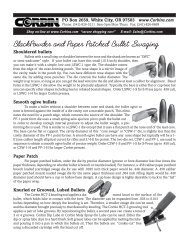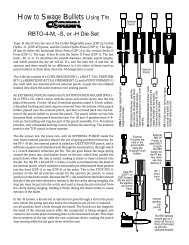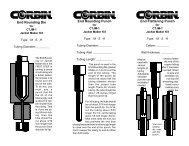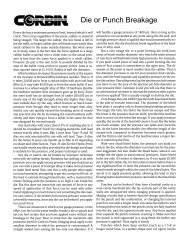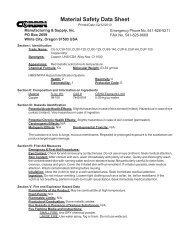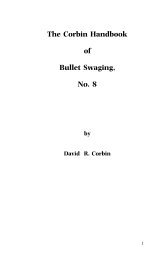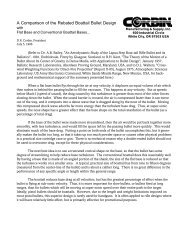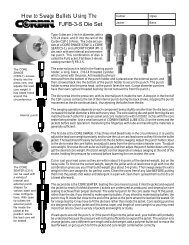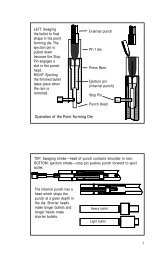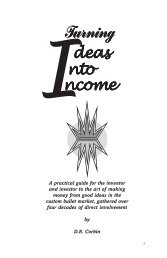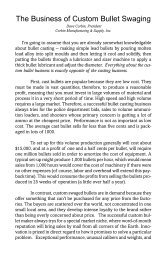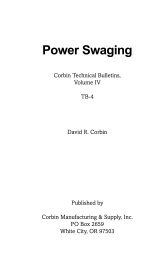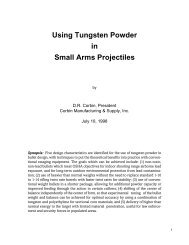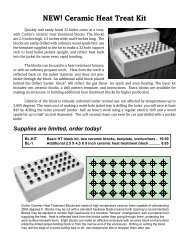HB-9 updated text (PDF) - Corbin Bullet Swaging
HB-9 updated text (PDF) - Corbin Bullet Swaging
HB-9 updated text (PDF) - Corbin Bullet Swaging
Create successful ePaper yourself
Turn your PDF publications into a flip-book with our unique Google optimized e-Paper software.
Dies Classified by Press Type<br />
We’ve talked about the basic design of bullet swage dies, in regard to<br />
their function. There is another category for classification of swage dies,<br />
and that is by the kind of press used to operate them. <strong>Swaging</strong> dies can be<br />
designed to operate in a reloading press (with severe limitations on pressure<br />
and precision), or in a number of different models of bullet swaging<br />
presses, both hand and hydraulic-electric powered.<br />
Years ago, we worked out a system of making standard parts for dies<br />
that would cover a wide range of calibers, and thus cut the cost of swaging<br />
through efficient use of what I call “semi-custom production”. We designed<br />
presses and die sets so that we could build similar punch and die<br />
blanks for certain ranges of calibers and bullet lengths, and then choose<br />
among perhaps three die body lengths for every caliber from .12 to .458<br />
in the hand presses, or from .224 to .998-in the dies for our big hydraulic<br />
presses.<br />
We didn’t have to design and build each die from scratch, because we<br />
built a standardized system for determining the minimum requirements<br />
of strength, die length, stroke length, punch geometry and strength, steels<br />
and heat treatment. We could run hundreds of blanks for each of the<br />
various presses, then hand-finish the cavities and hone the rough-finished<br />
punch blanks to a perfect fit during the custom phase of each order. It<br />
combined the economy of mass production with the flexibility and precision<br />
of custom tooling.<br />
<strong>Corbin</strong> swaging dies are up to ten times less costly than competitive<br />
dies without any sacrifice in precision because of this semi-custom production<br />
technique, and the fact that we design and build several different<br />
presses to take full advantage of the kind of operations you might want to<br />
undertake.<br />
The classification by press type also defines the die thread and diameter.<br />
The last letter in the catalog number identifies this classification.<br />
Dies with a catalog number ending in -R (such as the PRO-1-R) fit a<br />
standard 7/8-14 thread reloading press with an RCBS-type button shell<br />
holder ram. The die screws into the press head like a reloading die. The<br />
external punch slips into the T-slot of the ram. You do not also use a shell<br />
holder, since the punch base is made to simulate one.<br />
Dies with a catalog number ending in -M fit either the discontinued<br />
Silver Press, or the current S-Press. They are being phased out of stocking<br />
status in favor of the -S dies, which are larger and stronger, and fit the<br />
current S-Press or its predecessor, the Series II press (discontinued). However,<br />
we will continue to make them on special order, just not as a stock<br />
item. The -M dies have a 3/4-inch diameter main body, a thrust-adsorbing<br />
21



